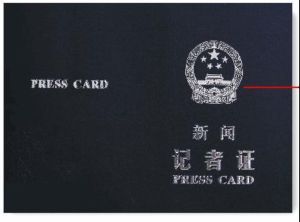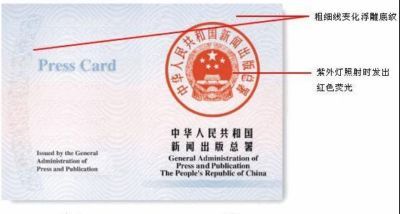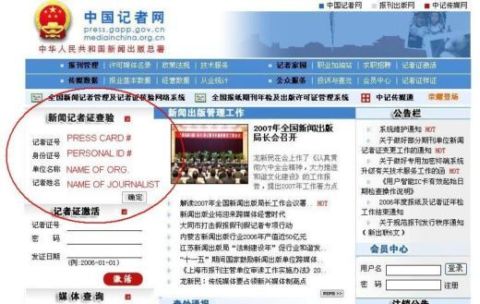Debate begins in the Lan Chengzhang Case: what does it mean to be a “real” journalist in China?
CMP reported yesterday that a face-off was shaping up in the case of the beating death of China Trade News reporter Lan Chengzhang (兰成长) — between local party officials in Datong, Shanxi Province (where the reporter was killed), who insist Lan was a “fake” reporter out to extort money from local coalmines, and representatives from China Trade News, who confirm they hired Lan on a provisional basis. More news and commentary appeared on the story today, which was first reported in yesterday’s Southern Metropolis Daily and appeared also on major Web portals. [BELOW: Image of cover of a Chinese press card from General Administration of Press and Publications website].
Lan’s identity as a journalist (or not?) remains one of the central questions, although some today are decrying the fact that this question has turned attention away from the search for Lan’s murderers.
What exactly does it mean to be a “journalist” in China? CMP offers a few facts below readers might find helpful as news in the Lan Chengzhang case continues to break.
Shanghai’s Oriental Morning Post, one of the city’s leading commercial papers, this morning quoted an editor at the news desk of China Trade News, Mr. Wang, who called the actions of officials in Datong suspicious: “Something happens on the 9th, and an official document comes out on the 10th. That really tells its own tale”, said Wang, referring to a public notice (tonggao) released by Datong government officials announcing the formation of a special “leading group” to deal with the problem of “fake reporters” and “fake publications”.
The notice was released on January 10 by the local Public Security Bureau and by the Datong office of the General Administration of Press and Publications (GAPP), the office tasked with regulating and controlling print media in China. The notice said anyone carrying out reporting activities but not bearing a “press card” issued by GAPP classified as a “fake reporter”.
Generally speaking, journalists must be licensed to work as journalists in China, a process requiring a request from a licensed news organization (usually made by the editor in chief), and fulfillment of certain conditions by the reporter (such as completion of a two-week training session in the Marxist View of Journalism).
The licensing of individual journalists can be viewed as one of four aspects of state-defined legitimacy in China’s journalism world, a way of enforcing control and discipline in the media ranks. Chinese Communist Party measures to define media legitimacy consist of the following: 1) licensing of news or media organizations (allowing media to be formed, and under what conditions), 2) licensing of reporters (issuing press cards and defining conditions), 3) controlling appointment of top media people (an editor in chief, for example, is approved by superior party leaders), 4) reserving the right to shut media down at any time, as suits the needs of party leadership. [BELOW: Image of inside page of a Chinese press card, from GAPP Website, with pointers for authentication].
However, the nature of China’s regulations governing the issue of press cards, and their conditions, make it inevitable that there will be journalists working in China without press cards, according to former Southern Weekend editor Zhang Ping, writing in today’s Southern Metropolis Daily. A professional qualifications system set up for media in 2003 as a condition for issuance of press cards meant that roughly 100,000 press workers had to undergo training and pass professional examinations to get their credentials, said Zhang — but they were given a period of five years to comply. Zhang added that management procedures for press cards, which took force in March 2005, made one year of work experience a precondition for issuing press cards to editorial staff (as opposed to business, advertising, etc).
In effect, said Zhang, these regulations mean one can reasonably expect, now and in the future, to have legitimate, working journalists without GAPP-issued press cards. “Using a press card to determine whether someone is engaged in [news] extortion or not is like using a temporary residency permit [issued to migrants living in China’s major cities] to determine whether someone is guilty of a crime or not — it violates the spirit of rule of law”.
“Of course government offices can make their own interpretations of these regulations, which were full of a hundred loopholes to begin with,” Zhang added. “But the undeniable fact is that across the country there are many journalists who do not have press cards, and that among these many are honest and upright, abiding strictly by the rules and writing very good news reports. [Zhang Ping explains these government regulations in Southern Metropolis Daily/more translation below].
Aside from Zhang Ping’s point about GAPP regulations on press card issuance, the fact is that a growing number of “journalists” working for bottom-of-the-barrel industry newspapers (行业报纸) in China are hired on a provisional basis, which means they may not carry press cards but have instead letters of introduction (介绍信) from publications that are legitimately registered. This segment of China’s commercialized media industry has become highly problematic. There are undoubtedly “legitimate” editors and reporters working for these types of publications — that is to say, they are doing their best to get real news out to their readership — but it is also most definitely true that “fake news” and “news extortion” are major problems at this level.
One cannot assume, though, as the Datong public notice seems to, that “news extortion” is limited to those lacking proper press credentials. It is happening everywhere, even at the highest levels, as illustrated by the 2002 bribery and news extortion case exposed by China Youth Daily reporter Liu Chang, in which four “journalists” from the official Xinhua News Agency were among those implicated. Officials are also too willing to use the “news extortion” brand to battle legitimate reporters with real stories disadvantageous to local governments — this charge was, in fact, leveled against Gao Qinrong, the reporter recently released after being jailed for eight years on trumped-up charges.
Even if press cards were the issue and all Chinese journalists carried them, chaos in the process of issuing these cards would leave a vast area of grey, and there would be legitimate doubts about who was a “real” journalist and who was not. Some journalists have told CMP of cases in which employees of media organizations who are not involved in newsgathering (drivers, office staff, etc.) possess “legitimate” press credentials, leaving open the potential for abuse. Others point out that press cards are notoriously easy to courterfeit.
The second problem is nominally addressed by the database of registered journalists (those having press cards) offered on the national Website of the General Administration of Press and Publications. The database is searchable, so that if a reporter walks into your office in Datong asking for an interview, you can plug his/her information into the GAPP site and view the status of their credentials. [BELOW: Screen capture from GAPP Website, searchable press card database circled in upper left with CMP translation].
The GAPP site also provides a running record of press cards as they are cancelled for various reasons (disciplinary, retirement), or if they have been lost or stolen. This database offers a taste of just how complicated the process of identifying a “real” journalist can be when the “journalist” label is defined and policed (and inevitably abused) by a vast and inefficient bureaucracy.
For Zhang Ping, responding to Lan Chengzhang’s murder in Southern Metropolis Daily today, the issue of press cards and “real” versus “fake” journalists is really about the overarching issue of speech freedoms in China. Zhang Ping makes the implicit point that all citizens should have the right to speak their minds and seek out informtion, regardless of whether or not they have press cards. Further, he argues that rigid notions of approved journalists do not fit well with interactive media and the modern information age:
Actually, news professionals are not like doctors, lawyers or accountants, with professional standards that can be tested — most countries worldwide do not have entry systems for the profession [of journalism], or at any rate strict ones. As traditional media grow, and as new media develop rapidly, this task [of setting up such a system] is perhaps an impossible one. For example, if someone without a press card sees something happen, can they post this information on the Web? If someone who does not have a press card simply wants to go to Datong to understand some information a little better, can they simply be attacked?
As for this beating death in Datong, those real local reporters [with press cards] haven’t uttered a word, and those Web users [who have dared to come forward with information] are exactly who Datong is attacking. What is the end result of this attack? What exactly does it mean to make this distinction between real and fake reporters?
Zhang Ping also called on industry colleagues to make their views known on the issue of “fake” reporters, the implication being that many publications in China have staff who might qualify as “fake” journalists under the Datong test: “I think all top editors across China should stand up and say with good conscience, have we hired “fake reporters”, are these [so-called] “fake reporters” [those without press cards] doing their job, is it right if they are attacked, should they be protected? ”
Media were also pointing out today that the debate over whether or not Lan Chengzhang was a “fake” reporter was turning attention away from the fact that his murder was a crime. Shanghai’s Oriental Morning Post quoted a Beijing-based criminal prosecutor as saying the incident in Datong [Lan’s murder] had “already violated China’s criminal law and the behavior of the perpetrator’s was an act of premeditated murder subject to a sentence of 10 or more years in prison”.
A second editorial on page A30 of Southern Metropolis Daily sought to turn the focus of the case to the question of finding those responsible for Lan Chengzhang’s attack and launching an official investigation of the coalmine involved: “Is it really so important whether the person murdered was a real or fake reporter?” the editorial asked.
LINKS:
“Journalist Beaten to Death in China After Mine Probe“, AFP
[Posted by David Bandurski, January 17, 2007, 4:00pm]





